Podcast: Play in new window | Download (Duration: 10:23 — 7.2MB) | Embed
Subscribe: Apple Podcasts | Spotify | Amazon Music | Android | Pandora | iHeartRadio | JioSaavn | Podchaser | Gaana | Podcast Index | Email | TuneIn | Deezer | Anghami | RSS | More
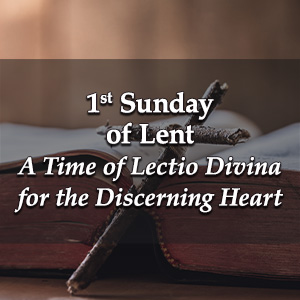 1st Sunday of Lent – A Time of Lectio Divina for the Discerning Heart Podcast
1st Sunday of Lent – A Time of Lectio Divina for the Discerning Heart Podcast
As you begin, take a deep breath and exhale slowly. For at least the next few moments, surrender all the cares and concerns of this day to the Lord.
Say slowly from your heart “Jesus, I Trust In You…You Take Over”
Become aware that He is with you, looking upon you with love, wanting to be heard deep within in your heart…
From the Holy Gospel of St. Matthew 4:1-11
Jesus was led by the Spirit out into the wilderness to be tempted by the devil. He fasted for forty days and forty nights, after which he was very hungry, and the tempter came and said to him, ‘If you are the Son of God, tell these stones to turn into loaves.’ But he replied, ‘Scripture says:
Man does not live on bread alone
but on every word that comes from the mouth of God.’
The devil then took him to the holy city and made him stand on the parapet of the Temple. ‘If you are the Son of God’ he said ‘throw yourself down; for scripture says:
He will put you in his angels’ charge,
and they will support you on their hands
in case you hurt your foot against a stone.’
Jesus said to him, ‘Scripture also says:
You must not put the Lord your God to the test.’
Next, taking him to a very high mountain, the devil showed him all the kingdoms of the world and their splendour. ‘I will give you all these’ he said, ‘if you fall at my feet and worship me.’ Then Jesus replied, ‘Be off, Satan! For scripture says:
You must worship the Lord your God,
and serve him alone.’
Then the devil left him, and angels appeared and looked after him.
What word made this passage come alive for you?
What did you sense the Lord saying to you?
Once more give the Lord an opportunity to speak to you:
Jesus was led by the Spirit out into the wilderness to be tempted by the devil. He fasted for forty days and forty nights, after which he was very hungry, and the tempter came and said to him, ‘If you are the Son of God, tell these stones to turn into loaves.’ But he replied, ‘Scripture says:
Man does not live on bread alone
but on every word that comes from the mouth of God.’
The devil then took him to the holy city and made him stand on the parapet of the Temple. ‘If you are the Son of God’ he said ‘throw yourself down; for scripture says:
He will put you in his angels’ charge,
and they will support you on their hands
in case you hurt your foot against a stone.’
Jesus said to him, ‘Scripture also says:
You must not put the Lord your God to the test.’
Next, taking him to a very high mountain, the devil showed him all the kingdoms of the world and their splendour. ‘I will give you all these’ he said, ‘if you fall at my feet and worship me.’ Then Jesus replied, ‘Be off, Satan! For scripture says:
You must worship the Lord your God,
and serve him alone.’
Then the devil left him, and angels appeared and looked after him.
What did your heart feel as you listened?
What did you sense the Lord saying to you?
Once more, through Him, with Him and in Him listen to the Word:
Jesus was led by the Spirit out into the wilderness to be tempted by the devil. He fasted for forty days and forty nights, after which he was very hungry, and the tempter came and said to him, ‘If you are the Son of God, tell these stones to turn into loaves.’ But he replied, ‘Scripture says:
Man does not live on bread alone
but on every word that comes from the mouth of God.’
The devil then took him to the holy city and made him stand on the parapet of the Temple. ‘If you are the Son of God’ he said ‘throw yourself down; for scripture says:
He will put you in his angels’ charge,
and they will support you on their hands
in case you hurt your foot against a stone.’
Jesus said to him, ‘Scripture also says:
You must not put the Lord your God to the test.’
Next, taking him to a very high mountain, the devil showed him all the kingdoms of the world and their splendour. ‘I will give you all these’ he said, ‘if you fall at my feet and worship me.’ Then Jesus replied, ‘Be off, Satan! For scripture says:
You must worship the Lord your God,
and serve him alone.’
Then the devil left him, and angels appeared and looked after him.
What touched your heart in this time of prayer?
What did your heart feel as you prayed?
What do you hope to carry with you from this time with the Lord?
Our Father, who art in heaven,
hallowed be thy name.
Thy kingdom come.
Thy will be done on earth, as it is in heaven.
Give us this day our daily bread,
and forgive us our trespasses,
as we forgive those who trespass against us,
and lead us not into temptation,
but deliver us from evil.
Amen

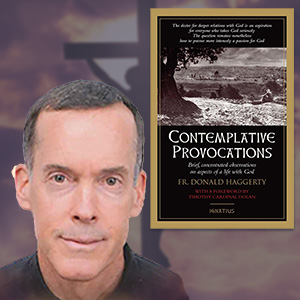
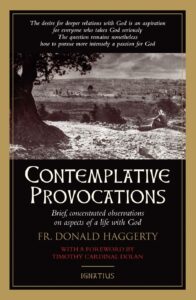
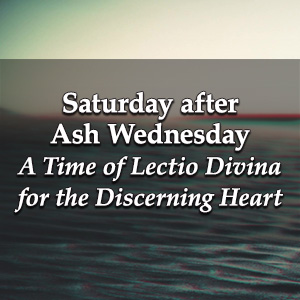 Saturday after Ash Wednesday – A Time of Lectio Divina for the Discerning Heart Podcast
Saturday after Ash Wednesday – A Time of Lectio Divina for the Discerning Heart Podcast
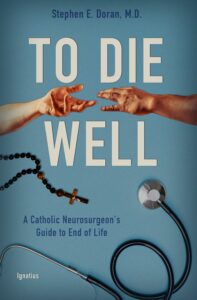
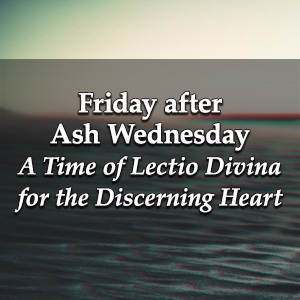 Friday after Ash Wednesday – A Time of Lectio Divina for the Discerning Heart Podcast
Friday after Ash Wednesday – A Time of Lectio Divina for the Discerning Heart Podcast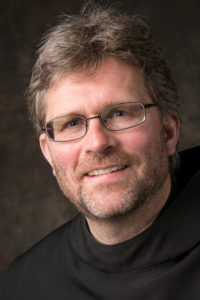
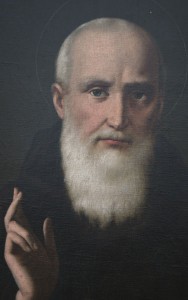
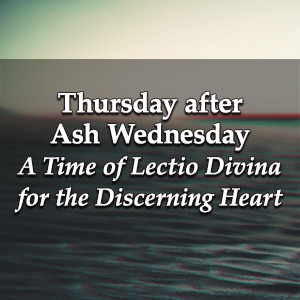 Thursday after Ash Wednesday – A Time of Lectio Divina for the Discerning Heart Podcast
Thursday after Ash Wednesday – A Time of Lectio Divina for the Discerning Heart Podcast